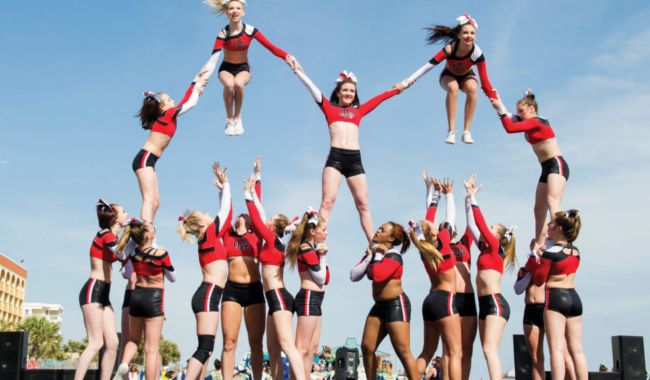There are many types of cheerleading jumps, ranging from simple, quick jumps to more complex contortions. Cheerleading competitions as well as sporting events use jumps.
Common Cheerleading Jumps
You will see certain jumps from squad to squad, state to state, and country to country. Coaches may have different names for these jumps, but they are all performed the same way.
Spread Eagle
This is probably one of the most basic jumps you will learn. Often, cheerleaders or younger squads learn this jump first. In this position, the arms are in a high V and the legs are extended, but the knees are facing forward instead of upward.
Toe Touch
Probably one of the most common jumps, the toe touch is fairly easy to execute. A “T” shape is formed by the arms and a V is formed by the legs, with the knees pointing outward or even backward. Despite the name, your hands will not touch your toes.
Tuck
Sometimes, this jump is seen in competitions. The knees are tucked into the chest, and the legs are in front. A “T” shape is formed with the hands to the sides.
Right or Left Hurdler
Hurdler is a really nice looking jump that looks like a stunt. As one leg is bent and the knee pointing down, the other leg will be in toe touch position with the knee pointing toward the sky.
Pike
The term “pike” is familiar to anyone who has taken a gymnastics class. Your feet are pointed straight out parallel to the ground with your toes pointed. The arms are straight in front, reaching toward the toes. In a fist, the hands are clasped together.
Pike-Out
Jumping this high is a bit challenging. As soon as the jumper lands, the legs are quickly moved into a toe touch position.
Herkie
It can be performed as a left or right Herkie in cheerleading. The jump is named after Lawrence Herkimer, the founder of the National Cheerleading Association. The left leg is bent with the knee facing downward, while the right leg is in toe touch formation. Legs form a “T” with arms doing the opposite. If the right leg is bent, the right arm is straight, and vice versa.
Double Nine
It is a complicated jump, but once you learn how to perform it, it is not difficult. There is a striking similarity between this jump and the pike jump, except that both arms and legs are bent to give the appearance of two nines.

How to Jump
Performing exercises that strengthen the calf muscles will help you master jumps. To prepare for any of the above jumps, here are the basics.
- Place your feet together and your arms by your sides in the starting position.
- In the second position, clasp your hands and raise them into a high V.
- The third position involves bending at the knees and crossing the arms in front of the knees at the wrist while swinging the arms down.
- The fourth position is where you jump. You get power from your legs. Performing the above steps rapidly is the goal.
- The final position is to land with your knees slightly bent and your arms to your sides after the jump.
- Return to a standing position after the jump. You can clasp your hands in front of you or keep your arms at your sides.
Master the Jumps
The jump is a basic cheerleading skill that should be mastered by all cheerleaders, whether they are just starting out or are seasoned veterans.
